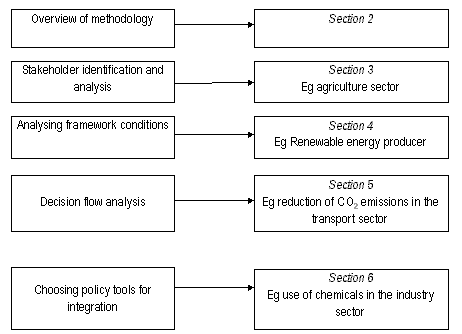Integration of Environmental Considerations at Different Levels of Decision Making
1. Introduction
| 1.1 | Context |
| 1.2 | Purpose |
| 1.3 | The approach |
| 1.4 | Structure of the report |
1.1 Context
ERM has been contracted by the Danish Environmental Protection Agency to undertake a study:
Developing a methodology for assessing progress with integration of environmental considerations at different levels of decision making (micro, meso, macro).
The importance of integrating environmental considerations into sectoral policy and wider decision making is a relatively new concept of environment policy. It was a key issue at the United Nations Conference on Environment and Development (‘Earth Summit’, Rio de Janeiro, 1992) which highlighted the need for environment to be integrated into the development processes. Agenda 21 (Chapter 8) describes objectives and activities for integrating environmental and developmental decision making at all levels and in all ministries. It also emphasises the need for everyone to take responsibility and act to change their behaviour, and in particular their production and consumption patterns. However, Agenda 21 only describes activities in a generic manner, and emphasises the need to adapt these to national and regional circumstances and conditions. It encourages research to improve the understanding of interactions between social, economic and environmental considerations and to assist with policy decisions. It also recognises that national institutional capability and capacity may need to be strengthened to facilitate integration at all levels of decision-making and implementation.
Partly in response to Agenda 21, the concept of integration is being promoted by the EC, EEA and Member State environment agencies as a key policy objective. At the European level the main interest is in promoting the concept and developing criteria for assessing progress. At the Member State level there is interest in developing systematic methodologies for assessing progress towards integration, and understanding how policy tools can be used to integrate environmental considerations in decision making processes to promote sustainable development. In the most basic terms the aim is to influence the supply and demand of goods and resources, to reduce adverse environmental impacts, and thereby move towards a position of sustainable production and consumption. Ultimately, market based actors should be aware of the impact of their actions and be in a position where the parameters underlying their decisions point towards the most sustainable option.
1.2 Purpose
The purpose of this study has been to develop a methodology for assessing the progress towards integration. The methodology presented here provides a structured approach for sectoral agencies to consider gaps in the current policy framework and to provide incentives for market based actors to make more sustainable consumption and production decisions. This framework will help to identify additional tools which could be used to progress integration, to establish the necessary conditions for their effective implementation and to identify the key stakeholders to be involved in the process.
1.3 The Approach
The methodology was developed through an analysis of decision making in four sectors: agriculture, energy, transport and industry. The approach taken was to understand the context for integration in Denmark, analyse the relationship between key market based actors and the frameworks they operate within, and develop a simple process for assessing progress and moving towards integration. This approach is outlined in Figure 1.1.
Figure 1.1
Study Approach Look here!
1.4 Structure of the report
The methodology is presented in Section 2. The remainder of the report is illustrated in Figure 1.2 and presents further explanation of key stages of the methodology illustrated with selected results from the sectoral analyses.
Figure 1.2
Structure of the Report.

| Section 3 describes the stakeholder analysis in terms of different actors, types of decisions and the parameters which affect these decisions. | |
| Section 4 provides an overview of the framework conditions for decision making. | |
| Section 5 describes the decision flow analysis and highlights the key framework conditions for successful implementation of integration tools. | |
| Section 6 presents a series of generic tools or instruments which could be used in many sectors and describes the type of actor and decision they are aimed at, the detailed requirements and wider framework conditions for effective application. |
A full description of the sectoral analyses are presented in a series of Annexes:
| Annex A: Agriculture | |
| Annex B: Energy | |
| Annex C: Transport | |
| Annex D: Industry |